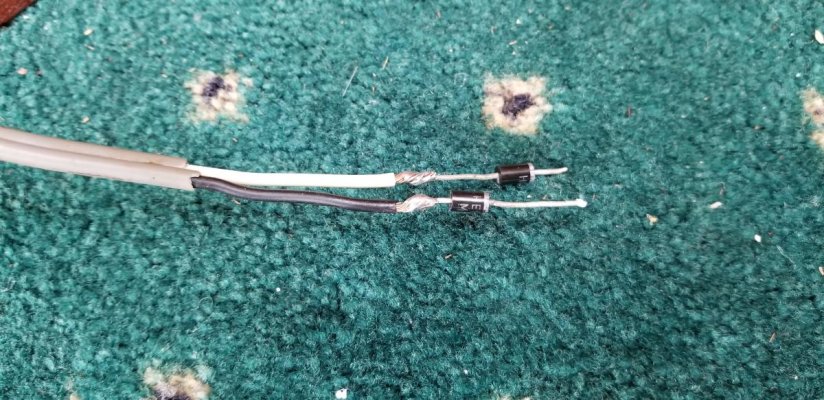sdowney717
Guru
- Joined
- Jan 26, 2016
- Messages
- 2,264
- Location
- United States
- Vessel Name
- Old Glory
- Vessel Make
- 1970 Egg Harbor 37 extended salon model
Some time ago, installed a continuous duty 150 amp relay to join battery banks 1 and 2
With 2 engines and 2 alternators, its been working good, the load on alt 1 drops in half and alt 2 picks up the difference when I throw switch on. This is clearly visible on the ammeters connected to alternators 1 and 2. Alternators are 12SI Delco.
I was told by some it would not work! That they would fight each other, and one would loaf.
Without the relay, depleted house battery bank 2 works alternator 2 really hard while alternator 1 just charges the starter bank 1 and loafs almost unloaded. The relay is extending the life of alternator 2. One time before I had this relay, alternator 2 belt burned up due to overloading and alternator got pretty hot.
The other advantage (if battery bank 2 is not depleted), the relay boosts the starting power for the engine starters, as they then have both battery banks 1 and 2 to draw from. I pretty much leave the helm switch on all the time, and you know its working because it makes an audible click when turning on.
The combining relay's on switch at helm was wired to the fuel pump of engine #1. I have since realized, I could use 2 diodes in the incoming power to the combining relay helm switch, so that either engine 1 or engine 2 could be on and the other engine off and the relay can come on. Right now engine 1 has to be running for combining relay to work, so I will probably make that mod soon. The diodes have to be big enough ones to handle the current for the relay coil. End of each diode would connect to the fuel pump or ignition on of each engine and other ends joined together into power in at helm switch for the relay. You have to get the diode facing the right way, think of it as a one way valve for electricity.
Power flows to switch and blocked if was coming from switch, that way turning on one engine ignition wont activate (backfeed) power to other engines ignition circuits.
When ignition is off, the relay is off, and the banks are not combined.
And I cant say if it would work with different kinds of alternators.
With 2 engines and 2 alternators, its been working good, the load on alt 1 drops in half and alt 2 picks up the difference when I throw switch on. This is clearly visible on the ammeters connected to alternators 1 and 2. Alternators are 12SI Delco.
I was told by some it would not work! That they would fight each other, and one would loaf.
Without the relay, depleted house battery bank 2 works alternator 2 really hard while alternator 1 just charges the starter bank 1 and loafs almost unloaded. The relay is extending the life of alternator 2. One time before I had this relay, alternator 2 belt burned up due to overloading and alternator got pretty hot.
The other advantage (if battery bank 2 is not depleted), the relay boosts the starting power for the engine starters, as they then have both battery banks 1 and 2 to draw from. I pretty much leave the helm switch on all the time, and you know its working because it makes an audible click when turning on.
The combining relay's on switch at helm was wired to the fuel pump of engine #1. I have since realized, I could use 2 diodes in the incoming power to the combining relay helm switch, so that either engine 1 or engine 2 could be on and the other engine off and the relay can come on. Right now engine 1 has to be running for combining relay to work, so I will probably make that mod soon. The diodes have to be big enough ones to handle the current for the relay coil. End of each diode would connect to the fuel pump or ignition on of each engine and other ends joined together into power in at helm switch for the relay. You have to get the diode facing the right way, think of it as a one way valve for electricity.
Power flows to switch and blocked if was coming from switch, that way turning on one engine ignition wont activate (backfeed) power to other engines ignition circuits.
When ignition is off, the relay is off, and the banks are not combined.
And I cant say if it would work with different kinds of alternators.
Last edited:

